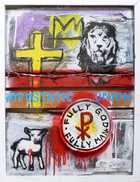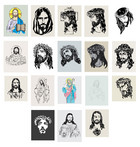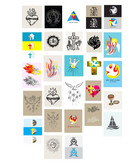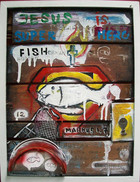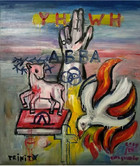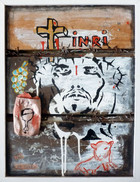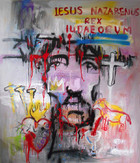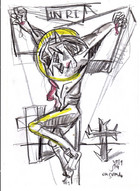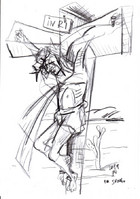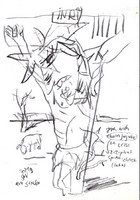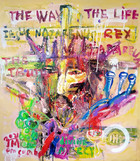Martinus Sumbaji
(b. 1973)
Any artist who makes found object pieces about the Hypostatic Union commands my attention, especially if they live on the island of Bali! Doctrine does not always make for good art, but Martinus Sumbaji illustrates these weighty words about the human and divine aspects of Christ with disarming simplicity, using familiar iconic images boxed in wood of the cross and crown, the lion and lamb, the Chi-Ro symbol of Christ and the slogan: FULLY GOD, FULLY MAN. Perhaps, in this era of globalized Christianity, it takes a 21st Century Indonesian art-maker to bring clarity to an arcane theological dispute among 5th century Christians in the Mediterranean world that resulted in a schism still unhealed to this day--as the strip of barbed wire reminds us!
Sumbaji, who signs his work as Em Sumba, was born in 1973 in Lampung, Sumatra, and baptized a Roman Catholic. His parents were Muslims who converted to Christianity and raised their children in the faith. Of Sumbaji’s twelve siblings, one became a priest and another a nun. He was the self-styled “rebel in the middle of the family.” In his early twenties, Sumbaji set off for the Indonesian capital of Jakarta and found work in 1995 in a Japanese animation studio. After five years of creating low-tech, hand drawn cartoon cels, Sumbaji decided to strike out on his own as a painter. He eventually settled on the island of Bali, where the lively arts and crafts scene offered possibilities for work.
The aspiring artist labored in the construction industry and made picture-postcard paintings and portraits from photos for the tourist market, creating more experimental pieces of his own for exhibitions. A personal tragedy and a visit home to Sumatra brought Sumbaji back to his childhood faith. He studied vector design and now markets logos on-line, some with Christ portraits and religious emblems, to supplement the family income, but painting remains his passion. Sumbaji, his wife, and daughter are active members of Bali’s small but vibrant Christian community, attending Mass at the Holy Spirit Roman Catholic Cathedral in the capital of Denpasar. He stands apart in his “street art” approach to sacred imagery.
The mathematics of vector commercial art is far-removed from Sumbaji’s expressionist painting style, influenced by artists as diverse as Vincent van Gogh, Edvard Munch, Francis Bacon, and Jean-Michel Basquiat. But in pieces in the collection like Hypostatic Union, SuperFISHman, and Trinity, he does “product branding” of the Christian message. Lines of text and iconic images like flaming doves, bleeding lambs (and the Superman logo!) make for flash recognition in viewers, when presented in the style of spray-painted graffiti. Sumbaji illustrates Christian dogmas like the Trinity and the divinity of Christ, especially difficult for the Muslim majority in Indonesia to understand, “to reinforce our faith through the language of art.”
Pieces in the Collection like INRI and INRi 2--using the traditional shorthand for the sign on the Cross: JESUS OF NAZARETH, KING OF THE JEWS--have the look of furtively made wall art, where paint still drips from the schematic features of Christ. Before committing an image to canvas or wood panel, Sumbaji takes time to develop his subjects in preliminary drawings. Four exaggeratedly Cubist pencil sketches in the gallery for a Crucifixion painting bring to mind images of Christ on the Cross in a figurative abstract expressionist style by Chinese Filipino Painter Ang Kuikok, an Asian Christian artist whom Sumbaji views as a mentor. Sumbaji has also created drawings on sacred themes in boldly clashing color.
Sumbaji believes there is nothing new under the sun in the world of art. He takes whatever inspires him from the works of artists new and old and “cooks it to my own taste.” The resulting cuisine is very varied. Bold and brassy bits of street art like Divine Mercy II are served up alongside delicately numinous portraits like the artist’s Bloody Son of Man in the Collection, where the fragile features of Christ seem as shimmering and insubstantial as the fleeting figures of Indonesian shadow puppetry. Says Sumbaji: “For the ideas to flow, I must spontaneously follow my thoughts and my heart when I make art on Christian themes.”
